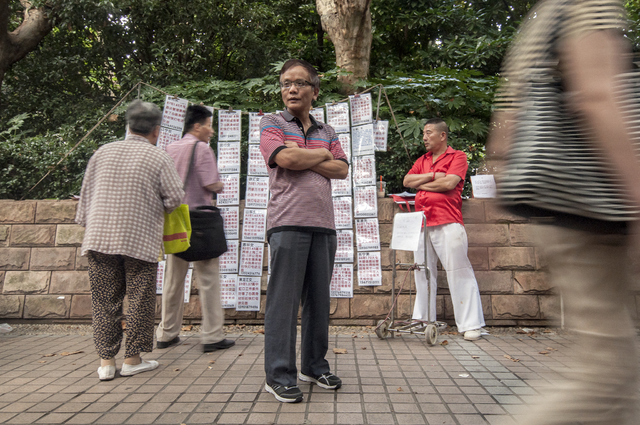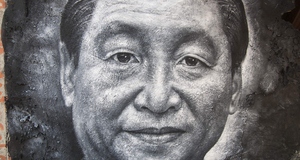Since 2004, the proliferation of marriage markets in China has made BaiFaXiangQin an attractive alternative for parents that are anxious and eager to help their single children find a suitable match for marriage. This paper discusses the possible cultural and financial reasons behind the increasing popularity of BaiFaXiangQin in mainland China and identifies the five steps used in BaiFaXiangQin to complete the marital selection process.
According to Zhou (2009), meeting or dating between two individuals of the opposite sex under the recommendation of a third party such as parents, neighbors, co-workers, relatives, or even matchmakers is traditionally known as XiangQin 相亲. Dating arrangements in China predominantly lead to marriage or more serious relationships. Tang and Zuo (2000) reported that while only 14 percent of American students share this view, a distinct 42 percent of Chinese college students in Mainland China aim to find a marital partner through dating.
In the phrase
BaiFaXiangQin (白发相亲),
BaiFa (白发) is used to describe parents, especially those in their 50s or 60s (Sun, 2012a). Combined, the phrase
BaiFaXiangQin refers to parental matchmaking that is conducted through marriage markets, an interesting and modern concept among the plethora of dating platforms in China.

"In Shanghai you can shop for anything." A Chinese marriage market in Shanghai, China. Photo/caption: Chris Bentley.
Out of more than 8000 Chinese couples surveyed in 1991 across 7 provinces, 77 percent of the couples were married by parental involvement. This is largely due to the wide acceptance of parental help in the matters of marriage and the selection of a spouse.
Parents are known to be more resourceful and experienced and are seen as individuals with better capabilities of evaluating the quality of marriage (Huang, Jin, & Xu, 2012). BaiFaXiangQin is simply another form of matchmaking in a controlled setting, driven primarily by the dwindling resources available to them (Sun, 2012b).
Marriage markets are common fixtures in many major parks around China today. Cities like Beijing, Shanghai, ShenZhen, and Wuhan play host to this progressively popular free matchmaking platform, specifically catered to parents aid their children in their endeavors to find a suitable spouse. Sun (2012a) described parents born in the 50s or 60s playing the role of vendors trying to peddle their children.
Typically, parents advertise their children by providing information regarding their unmarried children on advertisements; information may include age, height, job, income, education, Chinese zodiac sign, personality, family values, or even a picture of their single children (Winter, 2014; Yang, 2011). Some even detail the minimum requirements to apply for consideration. Advertisements are displayed around the park, some on designated notice boards. Parents also linger around the vicinity of their advertisement in case they spot an interested buyer.
The practice of matchmaking in this avenue is called BaiFaXiangQin and despite the wide acceptance of parental matchmaking in Chinese culture, parents often practice BaiFaXiangQin without informing their single children as some of them have expressed discomfort with their parents' involvement in the matter of their love lives (Tully, 2013; Hu, 2014).
The lack of an established social security and pension system plays a crucial role in the urgency found among parents of unmarried children to find a suitable marital spouse for them (Sun, 2012a). Approximately 70 percent of elderly parents need to financially depend on their offspring (Sun, 1998). In China, this problem has been named the "4:2:1" phenomenon, this illustrates the problem where one child has to be responsible for the welfare of two parents and four grandparents (Pozen, 2013).
Elderly parents would rely on their children and their children's marital spouse to provide for them in their retirement years. In Chinese culture, filial piety is a highly valued virtue that parents strive to cultivate. Filial piety can be shown when children provide care, respect, and financial support to their elderly parents. Children with this virtue can be a great source of happiness and pride (Yan, Chen, & Murphy, 2005; Hwang & Han, 2010). It is common in Chinese societies for parents to receive financial support from their children (Silverstein, Cong, & Li, 2006; Pei & Pillai, 1999).
Receiving financial support leads to better psychological well-being among parents, thus not as susceptible to depressive symptoms (Chou, Chi, & Chou, 2004). The financial support of parents is a common act that reflects filial piety. Despite this fact, Sun (2012a) believed that parents feel that the responsibility of caring for them will be too much for their child and prefer to find a partner for their child to share this burden.
In the West, parents tend not to exert any control in their children's lives when they reach adulthood. In China, Chinese parents still feel a sense of responsibility for their children's life in adulthood. Parents were fully responsible for their children's marriages in previous centuries; their children had no say in choosing their marital spouse (Chan, Ng, & Chin, 2010). In fact, parents continue to play a significant role in marital choices in China today (To, 2013).
Now, Marriage Markets are one of the ways that Chinese parents can feel that they are still upholding certain dating traditions, despite the declining popularity for arranged marriages (Bolsover, 2011). Non-relational factors, such as parental approval, still affect the choice of partners (Goodwin, 1999). The majority of children are still subject to opinions and expectations of parents regarding their marital endeavours (To, 2013).
According to Liu (1988), 40 percent of the 4874 married women surveyed in 1988 were in an arranged marriage, while approximately 36 percent were introduced to their spouses by people they knew. This survey indicates that the concept behind Marriage Markets mirrors the dating practices that were popularly used to attain marriage.
There is an increasing prevalence of late marriages (Wong, 2003). Many young Chinese are encouraged to establish a financial foundation and to focus on their career before settling for marriage. This in turn becomes a source of concern for Chinese parents that are anxious for their children to enter a marriage (Wei, 1983; Hunt, 2013).
According to Liu (2004), single Chinese women reaching middle adulthood will be pressured by parents and peers to settle down and get married. Single Chinese women are subjects for derision. There are a lack of positive concepts to describe independent successful women (To, 2013). Thus, marriage is seen as a necessity for Chinese women. The patriarchal culture spurs their parents' enthusiasm in finding potential partners for their daughters in Marriage Markets (Yang, 2011).
In addition to finding potential spouses for their children, Marriage Markets also aid in satisfying the need for Chinese parents to shoulder the responsibility regarding their children's marriage prospect. For many Chinese, happiness is derived from family and children (Hwang & Han, 2010). Having many grandchildren and having children that practice filial piety are sources of great happiness for Chinese parents. To achieve this happiness, Chinese parents prefer to take a proactive role to ensure that their children will find a good partner (Sun, 2012a).
Therefore, many Chinese parents are willing to practice BaiFaXiangQin in Marriage Markets despite having to overcome the possibility of losing "face" or mianzi. According to Ho (1976), "face" can be defined as follows:
Face is the respectability and/or deference which a person can claim for himself from other, by virtue of the relative position he occupies in his social network and the degree to which he is judged to have functioned adequately in that position as well as acceptably in his general conduct; the face extended to a person by others is a function of the degree of congruence between judgments of his total condition in life, including his actions as well as those of people closely associated with him, and the social expectations that others have placed upon him. In terms of two interacting parties, face is the reciprocated compliance, respect, and/or deference that each party expects from, and extends to, the other party.
Face is an essential element in Chinese culture (Gilbert, 1927; Smith, 1894). Face is a social constraint that represents an internalised force of self-restriction and reflects public trust in the individual's morality (Hwang & Han, 2010).
It is the evaluation of an individual's public image in a particular social situation (Brown & Levinson, 1987; Alexander & Knight, 1971; Alexander & Rudd, 1981), and for parents to depart from performing certain social roles to save face (Hu, 1944) shows the parents' urgency to help their single children to find a potential spouse.Continued on Next Page »
Ahuvia, A. C., & Adelman, M. B. (1992). Formal intermediaries in the marriage market: A typology and review. Journal of Marriage and the Family, 54, 452–463.
Alexander, C. N., & Knight, G. W. (1971). Situated identities and social psychological experimentation. Sociometry, 24, 65-82.
Alexander, C. N., & Rudd, J. (1981). Situated identities and response variables. In J.T.Tedeschi (eds.), Impression management theory and social psychological research (pp. 83-103). New York: Academic Press.
Albright, L., Kenny, D. A., & Malloy, T. E. (1988). Consensus in personality judgments at zero acquaintance. Journal of Personality and Social Psychology, 55, 387-395.
Boase, J., & Wellman, B. (2004). Personal relationships: On and off the Internet. Cambridge University Press.
Bolsover, G. (2011, October 17). What's it like inside Shanghai's 'Marriage Market'?. CNN. Retrieved May 27, 2014, from: http://travel.cnn.com/shanghai/life/people-behind-paper-846851
Borkenau, P., & Liebler, A. (1992). Trait inferences: Sources of validity at zero-acquaintance. Journal of Personality and Social Psychology, 62, 645-657.
Brown, P., & Levinson, S. C. (1987). Politeness: Some universal in language usage. New York: Cambridge University Press.
Chan, D. K. S., Ng, T. T. T., & Chin, M. H. (2010). Interpersonal relationships in rapidly changing Chinese Societies (pp. 515-532). In M. H. Bond (Eds.), The Oxford Handbook of Chinese Psychology. New York, United States: Oxford University Press.
Chang, H-C., & Holt, G. R. (1991a). The concept of yuan and Chinese interpersonal relationships. In S. Ting-Toomey & F. Korzenny (Eds.), Cross-cultural interpersonal communication (pp. 28-57). Newbury Park, CA: Sage.
Chang, H-C., & Holt, G. R. (2002, November). Yuan (predestined relations): The fate of affective communication. Paper presented at the annual meeting of National Communication Association, New Orleans, LA.
Chang, S-C., & Chan, C. N. (2007). Preceptions of commitment change during mate selection: The case of Taiwanese newlyweds. Journal of social and Personal Relationships, 24(1), 55-68. doi: 10.1177/026540750072583
Chou, K. L., Chi, I., & Chow, N. W. S. (2004). Sources of income and depression in elderly Hong Kong Chinese: Mediating and moderating effects of social support and financial strain. Aging & Mental Health, 8, 212–221.
Coontz, S. (2005). Marriage, a history. New York, NY: Viking.
DePaulo, B. M. (1992). Nonverbal behaviour and self-presentation. Psychological Bulletin, 11, 203-243.
Efran, M. G. (1974). The effect of physical appearance on the judgment of guilt, interpersonal attraction, and severity of recommended punishment in a simulated jury task. Journal of Research in Personality, 8, 45-54.
Ekman, P., & Friesen, W. V. (1974). Detecting deception from body or face. Journal of Personality and Social Psychology, 29, 288-298.
Fali, H., Jin, G. Z., & Xu, L. C. (2012). Love and money by parental matchmaking; Evidence from urban couples in China. American Economic Review, 102(3), 555-560.
Fincher, L. H. (2014). Leftover Women: The Resurgence of Gender Inequality in China. London, New York: Zed Books.
Finkel, E. J., Eastwick, P. W., Karney, B. R., Reis, H. T., & Sprecher, S. (2012). Online dating: A critical analysis from the perspective of psychological science. Psychological Science in the public Interest, 13(1), 3-66. doi: 10.1177/1529100612436522
Fong, M., & Fincher, L. H. (2014, 24 April). If you are not married by 25, you are a 'leftover woman' in China. ChinaFile. Retrieved on June 11, 2014, from: http://www.huffingtonpost.com/2014/04/24/china-gender-inequality_n_5207388.html
Gibbs, J. L., Ellison, N. B., & Lai, C. (2011). First comes love, then comes Google: An investigation of uncertainty reduction strategies and self-disclosure in online dating. Communication Research, 38, 70–100.
Gilbert, R. Y. (1927). What's wrong with China. London: J.Murray.
Goodwin, R. (1999). Personal relationships across cultures. London: Routledge.
Goodwin, R., & Findlay, C. (1997). 'We were just fated together' ... Chinese love and the concept of yuan in England and Hong Kong. Personal Relationships, 4, 85–92.
Hertlein, K. M., & Ancheta, K. (2014). Advantages and disadvantages of technology in relationships: Findings from an open-ended survey. The Qualitative Report, 19(22), 1-11. Retrieved from http://www.nova.edu/ssss/QR/QR19/hertlein22.pdf
Ho, D. Y. F. (1976). On the concept of face. American Journal of Sociology, 81, 867-884.
Hu, H-C. (1944). The Chinese concepts of face. American Anthropologist, 46(1), 45-64.
Hunt, K. (2013, November 4). Glut of women at Shanghai's marriage market. CNN. Retrieved April 21, 2014, from: http://edition.cnn.com/2013/11/03/world/asia/shanghai-marriage-market/
Hwang, K. K., & Han, K. H. (2010). Face and morality in Confucian society. In M.H. Bond (Eds.), The Oxford Handbook of Chinese Psychology (pp. 479-498). New York, United States: Oxford University Press.
Jiang, L., Bazarova, N. N., & Hancock, J. T. (2011). The disclosure intimacy link in computer mediated communication: An attributional extension of the hyperpersonal model. Human Communication Research, 37, 58–77.
Kotajima, Y. (1990). On "en": China and Japan. Tokyo: Shintensha.
Lee, D. J., & Subramanian, S. (2011, October 19). Fo China's educated single ladies, finding love is often a struggle. The Atlantic. Retrieved June 11, 2014, from: http://www.theatlantic.com/international/archive/2011/10/for-chinas-educated-single-ladies-finding-love-is-often-a-struggle/246892/
Liu, J. (2004). Holding up the sky? Reflections on marriage in contemporary China. Feminism and Psychology, 14, 195–202.
Liu, Y. (1988). Marriage and the family. Beijing Review, 31 (May 23–29), 23–25.
Long, B. L. (2010). Scripts for online dating: A model and theory of online romantic relationship initiation (Unpublished doctoral dissertation). Bowling Green State University, OH.
McKenna, K. Y. A., Green, A. S., & Gleason, M. E. J. (2002). Relationship formation on the Internet: What's the big attraction? Journal of Social Issues, 58, 9–31.
Milgram, S. (1984). Cities as social representations. In R.M. Farr & S. Moscovici (Eds).
Naumann, L. P., Vazire, S., Rentfrow, P. J., & Gosling, S. D. (2009). Personality judgments based on physical appearance. Personality and Social Psychology Bulletin, 35(12), 1661-1671. doi:10.1177/0146167209346309
Pei, X., & Pillai, V. K. (1999). Old age support in China: The role of the state and the family. International Journal of Aging and Human Development, 49, 197–212.
Pozen, R. C. (2013). Tackling the Chinese pension system. Paulson Policy Memorandum. The Paulson Institute.
Reis, H. T., & Shaver, P. (1988). Intimacy as an interpersonal process. In S. Duck (Ed.), Handbook of personal relationships (pp. 367–389). Chichester, UK: Wiley.
Riggio, R. E., Widaman, K. F., Tucker, J. S., & Salinas, C. (1991). Beauty if more than skin deep: Components of attractiveness. Basic and Applied Social Psychology, 12, 423-439.
Silverstein, M., Zhen, C., & Li, S. (2006). Intergenerational transfers and living arrangements of older people in rural China: Consequences for psychological well-being. Journal of Gerontology, 61B, 256–266.
Smith, A. H. (1894). Chinese characteristics. New York: F.H. Revell Company.
Stander, V. A., Hsiung, P-C., & MacDermid, S. (2001). The relationship of attributions to marital distress: A comparison of mainland Chinese and U.S. Couples. Journal of Family Psychology, 15(1), 124-134. doi: 10.1037/0893-3200.15.1.124
Sun, F. (1998). Ageing of the population in China: trends and implications. Asia Pacific Population Journal, 13, 75-92.
Sun, P-D. (2012a). Who will marry my daughter?: Shanghai's Marriage Market and 'BaiFaXiangQin'. Beijing, China: China Social Sciences Press. (In Chinese)
Sun, P-D. (2012b). Parental matchmaking for children's marriage: An analysis of the marital spouse selection behaviours in the Parental Matchmaking Corner in Shanghai. South China Population, 27(110), 30-36. (In Chinese)
Tang, S. & Zuo, J. (2000). Dating attitudes and behaviors of American and Chinese college students. Social Science Journal,37, 67–78.
To, S. (2013), Understanding Sheng Nu ("Leftover Women"): the Phenomenon of Late Marriage among Chinese Professional Women. Symbolic Interaction, 36, 1–20. doi: 10.1002/symb.46
Todorov, A., Mandisodza, A. N., Goren, A., & Hall, C. C. (2005). Inferences of competence from faces predict election outcomes. Science, 308, 1623-1626.
Tong, S. T., & Walther, J. B. (2011). Just say ''no thanks'': Romantic rejection in computer-mediated communication. Journal of Social and Personal Relationships, 28, 488–506.
Tully, J. (2013, August 17). Chinese parents turn to market to marry off late-20s 'leftover ladies'. The Seattle Times. Retrieved April 21, 2014, from: http://seattletimes.com/html/nationworld/2021629359_leftoverladiesxml.html
Ueno, C. (1987). Selectable en and unselectable en. In Y. Kurita (Ed.), Japanese human relationship. Tokyo: Domesu Shuppan.
Warner, D. (2010, February 11). Shanghai's marriage market: Bridal bliss or marital mayhem?. CNN. Retrieved July 11, 2014, from: http://travel.cnn.com/shanghai/play/sausage-fest-2020-future-shanghai-marriage-market-086672
Wei, Z. (1983). Chinese family problems: Research and trends. Journal of Marriage and the Family, 45, 943–948.
Whitty, M. T., & Carr, A. (2006). Cyberspace romance: The psychology of online relationships. New York, NY: Palgrave Macmillan.
Whitty, M. T. (2008). Revealing the "real" me, searching for the "actual" you: Presentations of self on an internet dating site. Computers in Human Behavior, 24, 1707–1723.
Winter, C. (2014, February 12). Does the West have a monopoly on romantic love? Retrieved April 21, 2014, from: http://www.pri.org/stories/2014-02-12/does-west-have-monopoly-romantic-love
Wong, O. H. (2003). Postponement or abandonment of marriage? Evidence from Hong Kong. Journal of Comparative Family Studies, 34, 531–554.
Xu, X. (1994). The determinants and consequences of the transformation from arranged marriages to free-choice marriages in Chengdu, the People's Republic of China. In P. L. Lin, K. W. Mei, & H. C. Peng (eds), Marriage and the family in Chinese societies (pp. 249-266). Indianapolis, IN: University of Indianapolis Press.
Yan, J., Chen, C., & Murphy, M. (2005). Social support for older adults in China. Psychological Science (China), 28, 1496–1499. (In Chinese)
Yang, K. S. (1988). The Concept and function of yuan in Chinese society. In K. S. Yang (Eds.), The psychology of Chinese people (pp. 123-154). Taipei: Kwei Kwan.
Yang, Y-J. (2011, May 30). A marriage made in the city park. China Daily USA. Retrieved June 11, 2014, from: http://usa.chinadaily.com.cn/life/2011-05/30/content_12602013.htm Zhou, D-D. (2009). The research regarding the flourish of dating fairs. Legal and Economy (China), 194, 137-139. (In Chinese)




















